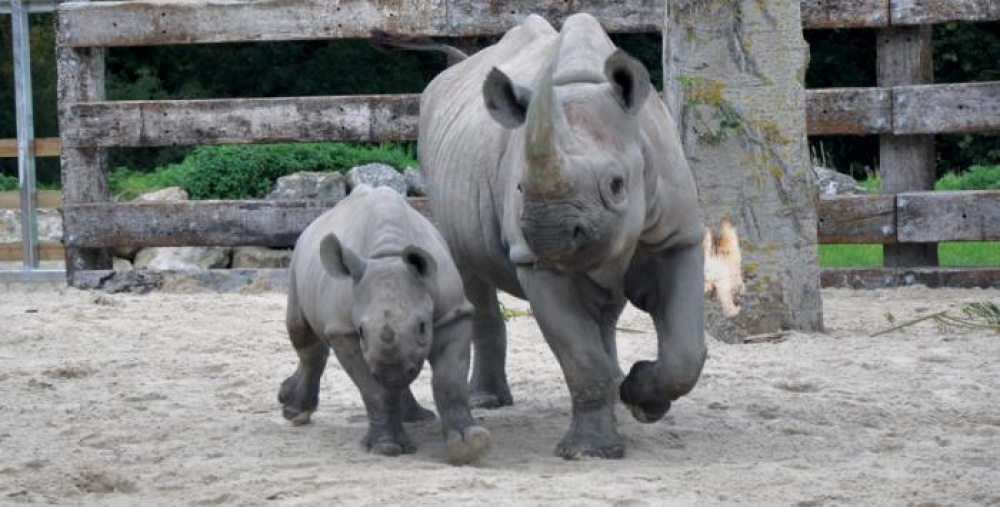Meet Olmoti, The Eastern Black Rhinoceros Who Is Swapping Yorkshire’s Flamingo Land for the Wild

Yorkshire’s Flamingo Land has kickstarted a year-long international project to help secure the long-term future of the endangered Eastern black rhinoceros population in Africa – by sending their youngest rhino, Olmoti, back into the wild
Four-year-old Olmoti has recently left her home at Flamingo Land to embark upon a year-long expedition that will culminate in her arrival at Rwanda’s Akagera National Park – a varied 112–hectare domain encompassing woodland, swamps, low mountains and savannah that is home to giraffe, lions, zebras and elephants.
Olmoti’s first step has been to leave her North Yorkshire home for Dvur Králové Zoo in the Czech Republic, a zoo which already has experience of returning rhinos back to Africa, and where she is set to meet the four other black rhinos who are to be her companions in the move – all having been carefully selected to ensure continuing genetic diversity within the park’s black rhino population.
‘There are less than 100 black rhinos in European zoos,’ explains Ross Snipp, Zoo Manager of Flamingo Land. ‘It’s not a big population, so it needs to be managed very carefully. You don’t want to breed animals that are too closely related because that can lead to genetic issues long term. It’s about not putting all your eggs in one basket, so to speak. It’s challenging because, as we have just done with Olmoti, it often means moving animals great distances across Europe, but it gives us that larger gene pool and the support of lots of different zoos contributing to populations.’
While she was born in Zurich Zoo, Olmoti has spent most of her life in Malton – having first arrived at Flamingo Land in September 2015, with her mother Samira, as a playful, mischievous nine-month-old who knew how to make an entrance, how to wind her fellow rhinos up, and how to get her own way.
‘She was tiny,’ laughs Ross. ‘Well, I say tiny, she was maybe a couple of hundred kilograms! But like any young animal, she’s full of life, full of energy, playful and a bit mischievous. She was always winding her mum up and winding up Chanua, the other female, who has become like a big sister to her. And she is very vocal. Lots of squeaking, lots of calling. We would often find, if the other rhinos were lying down, Olmoti would climb up on top of their backs. She’s just like a big puppy. She’s four now, so she’s getting to be a big girl, but that is her character and hopefully she’ll always have that fun, sightly mischievous side to her.’
Flamingo Land are heavily invested in rhino conservation. Already the co-ordinators of the global studbook for white rhinoceros, the zoo applied for the European Endangered Species Programme-certified Black Rhino Breeding Programme five years ago in order to develop that commitment by providing for a second species at the park. And, as the increasingly precarious status of the black rhino population proves, this type of conservation is not only admirable but very necessary.
Since the 1970s, the global population of black rhinos has declined by a staggering 96 percent – plummeting from 70,000 individuals recorded in 1970 to just 2,410 in 1995. While the persistent efforts of conversation programmes across Africa (and beyond) have meant that their numbers have since risen slightly to a current population of somewhere between 5,042 and 5,458 individuals, the black rhinoceros remains, officially, only one step away from extinction.
‘There are only five species of rhinos remaining, because we have decimated the populations,’ explains Ross. ‘There are two species in Africa, white and black. Black rhinos are critically endangered. On a sliding scale, at one end you’ve got “not threatened” – so, for example, the domestic dog – and at the other end of the spectrum is “extinct”, and we all know what that word means. One step before ”extinct” is “critically endangered”. What is really shocking is that if we do not reverse the trend for rhinos in general, within our lifetime they will disappear. And, in fact, conservationists have predicted that within the next 15 years all five species of rhinos will be gone in the wild.
‘Did you know that a rhino became extinct this year? No-one does – because It doesn’t make good TV. But we all know who is on I’m A Celebrity or Love Island, and we all care about Teresa May and Brexit. The last male northern white rhino died this year, but it didn’t make the headlines. There are thousands of people working to protect rhinos, and we are just a small piece of that huge jigsaw, but if we, as a race, don’t do something they will disappear. I’ve got an eight-year-old and a three-year-old, and to think that when they’re my age they’ll live in a world where there are no wild rhinos is just baffling.’
While to many of us it beggars belief, as with the other four species, the main threat facing the black rhinoceros comes from poachers. For centuries, rhino horn has been used in traditional Asian medicines – believed to contain almost magical healing properties – and is, pound-for-pound, more valuable than gold on the black market. And while it is now illegal to trade black rhino horn internationally, the scale of their persecution across Africa has meant that a large proportion of the black rhino remaining now reside in reserves and sanctuaries to offer as much protection as possible.
‘Rhino horn has no beneficial properties to anyone other than a rhino,’ says Ross. ‘As a lot of people now know, it’s just compacted hair, made of keratin. So they’re being hunted and wiped out for hair. On average, three rhinos are poached every day.’
Thankfully, poaching at Akagera National Park – Olmoti’s future home – has decreased by 97 percent in the last three years. This is the result of tireless efforts from a large team of rangers in the park who have installed and maintained sophisticated security and communication measures. With the Eastern black rhino currently found in only a handful of protected locations across Africa, Olmoti’s return to the wild, and her integral role in the potential replenishment of the dwindling population of black rhinos in Africa, has been described as a ‘once-in-a-lifetime event’ for all involved.
‘The rhinos are scheduled to arrived in Rwanda by July next year, and they’ll be monitored continuously,’ Ross explains. ‘There’ll be a settling in period where they’ll have constant care, so Olmoti’s day-to-day provisions won’t change initially. Food, water and veterinary care will all be provided. Then it’s a slow process of removing that and introducing wild foods, to the point where they can, one day, open the gates and allow those five rhinos to just wander out into the National Park. But they’ll still be monitored 24/7. They have to be, because the risk is massive. Of course it is. But we’ve got to take that risk – we’ve got to do it for Olmoti, and we’ve got to do it for black rhinos.
‘Every single person involved, including myself, would agree that we must have black rhinos in the wild. I’ve worked in zoos for 20 years, I’m a big believer in the role that zoos can play, but if I thought that the only place for a rhino was a zoo, I’d be wrong. The idea of no longer having them in the wild isn’t worth thinking about.’
Our Neck Of The Woods
Flamingo Land’s ties to Africa don’t end with Olmoti. The zoo’s Udzungwa Forest Project is an integrated conservation, research and education project based in Tanzania – aiming to break new ground for zoo-funded conservation by bridging the typically large gap between research and conservation
‘The UFP is primarily focused around an area of lowland forest in Tanzania called Magombera Forest, which is effectively an island about the size of the city of York, completely surrounded by sugar plantations,’ Ross explains. ‘So it’s not an island in the sense of being out in the ocean, but the animals that live within that remaining patch of forest are now completely isolated. Our scientists there have discovered species that exist in that patch of forest that live nowhere else in the world. So if the forest is destroyed, their only known home will disappear forever. We work to protect and understand the forest, collaborating with the communities that live in and around the forest that rely on that habitat.
‘This year, we have – together with some partners – actually bought and secured the forest, so we can now maintain it forever as a protected reserve. That’s been a huge step for us. It’s a fantastic project, and we knew that black rhinos could be a good ambassador species to help link our visitors at Flamingo Land to our conservation programme, because within the area that we work, black rhinos are still just about hanging on. By being involved in the EEP Black Rhino Breeding Programme, and by keeping black rhinos at Flamingo Land, it gives us a chance to say to people: here’s an iconic African species – by supporting them, you’re also supporting wider conservation work in their home of Tanzania.’
To find out more about the Udzungwa Forest Project, visit www.flamingoland.co.uk







